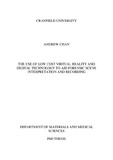JavaScript is disabled for your browser. Some features of this site may not work without it.
| dc.contributor.advisor | Lane, D W | |
| dc.contributor.author | Chan, A | |
| dc.date.accessioned | 2011-01-11T16:49:29Z | |
| dc.date.available | 2011-01-11T16:49:29Z | |
| dc.date.issued | 2011-01-11 | |
| dc.identifier.uri | http://dspace.lib.cranfield.ac.uk/handle/1826/4722 | |
| dc.description | © Cranfield University 2005. All rights reserved. No part of this publication may be reproduced without the written permission of the copyright owner. | en_UK |
| dc.description.abstract | Crime scenes are often short lived and the opportunities must not be lost in acquiring sufficient information before the scene is disturbed. With the growth in information technology (IT) in many other scientific fields, there are also substantial opportunities for IT in the area of forensic science. The thesis sought to explore means by which IT can assist and benefit the ways that forensic information can be illustrated and elucidated in a logical manner. The central research hypothesis considers that through the utilisation of low cost IT, the visual presentation of information will be of significant benefit to forensic science in particular for the recoding of crime scenes and its presentation in court. The research hypothesis was addressed by first exploring the current crime scene documentation techniques; their strengths and weaknesses, giving indication to the possible niche that technology could occupy within forensic science. The underlying principles of panoramic technology were examined, highlighting its ability to express spatial information efficiently. Through literature review and case studies, the current status of the technology within the forensic community and courtrooms was also explored to gauge its possible acceptance as a forensic tool. This led to the construction of a low cost semi-automated imaging system capable of capturing the necessary images for the formation of a panorama. This provides the ability to pan around; effectively placing the viewer at the crime scene. Evaluation and analysis involving forensic personnel was performed to assess the capabilities and effectiveness of the imaging system as a forensic tool. The imaging system was found to enhance the repertoire of techniques available for crime scene documentation; possessing sufficient capabilities and benefits to warrant its use within the area of forensics, thereby supporting the central hypothesis. | en_UK |
| dc.language.iso | en | en_UK |
| dc.title | The use of low cost virtual reality and digital technology to aid forensic scene interpretation and recording | en_UK |
| dc.type | Thesis or dissertation | en_UK |
| dc.type.qualificationlevel | Doctoral | en_UK |
| dc.type.qualificationname | PhD | en_UK |
| dc.publisher.department | Department of Materials and Applied Science | en_UK |
